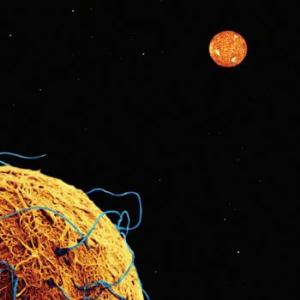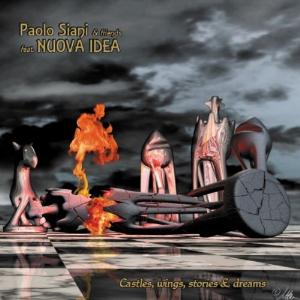TRACKLISTING:
1. Where Are They Now? (20:38)
2. The Mind’s Eye (8:15)
3. Perdu Dans Paris (10:47)
4. Paroxetine 20mg (7:15)
5. A Sale of Two Souls (7:51)
6. GPS Culture (7:00)
7. The Music That Died Alone (7:51)
8. In Darkest Dreams (including “After Phaedra”) (21:25)**
** on DVD disc only
LINEUP:
Andy Tillison – lead vocals, keyboards
Jonathan Barrett – bass
Luke Machin – guitar, vocals
Tony Latham – drums
Theo Travis – saxophones, flute
Just like Phideaux, The Tangent are one of those bands that do not need to be introduced to prog fans – unless they are the kind that adamantly refuses to listen to anything produced later than 1989. In spite of their frequent line-up changes, the fiercely independent outfit, based in an artistically fertile area like the north of England, has always been much more than just a vehicle for the undisputed talent of Andy Tillison – keyboardist, singer and songwriter with a a passion for the making of progressive rock with a keen edge of social and political awareness. Straddling the line between vintage and modernity, The Tangent have established a reputation for thought-provoking music with a healthy dose of dry British wit, and the kind of technical brilliance that is put at the service of the music rather than the other way around.
As the title indicates, Going Off on Two is the logical follow-up to the band’s first live album and DVD, released in 2007 and titled Going Off on One – though the line-up has undergone yet another overhaul (and, at the time of writing, has further changed, with drummer Nick Rickwood replacing Tony Latham). However, while the 2007 set was based on actual concerts, for Going Off on Two The Tangent have chosen a bold, unusual format that may well set a trend within the prog scene. Making full use of a live-in-the studio situation, the band are playing, to all intents and purposes, before a worldwide audience: the numerous fans from over 40 countries that have helped the DVD happen through their financial support. Recorded over a period of five days in December 2010 in a converted abattoir in the town of Stockport (on the outskirts of Manchester), it was inspired by popular Seventies TV programmes such as the legendary “The Old Grey Whistle Test”, whose performances often resulted in much sought-after recordings. The “gig” brings together the best of two worlds, the immediacy of a live performance and the relative comfort of the studio surroundings.
The polar opposite of the shallow, image-driven acts that command the attention of modern audiences, the band members are five refreshingly ordinary men of various ages that look as if they are genuinely having fun, in spite of the high level of complexity of their music – they are even shown dancing outside the studio in the end credits of the DVD. Dressed in comfortable, everyday clothes, obviously at ease with each other, they certainly do not deserve the vicious jibes flung at them by some alleged music journalist with a shockingly unprofessional attitude. Thankfully, progressive rock is not the sole prerogative of young, good-looking hipsters, and prog artists have every right to look like “accountants and sheep farmers” instead of posing as something they are not.
The 90-minute DVD, filmed by experienced documentary director Paul Brow, comes strikingly packaged with stunning cover artwork by renowned artist Ed Unitsky (a longtime collaborator of the band). While it contains few extras, they will definitely be of interest to fans of the band, or even to those who are getting acquainted with them. The images are crisp and clean, and the excellent photo gallery depicts the band members in various, often humorous situations, emphasizing their endearingly down-to-earth attitude. Though mostly focused on technical matters, the interviews are liberally laced with humour, and can be enjoyed even by those who (like myself) are not practising musicians. I especially liked the part in which Tillison explains his use of computers to generate all sorts of keyboard sounds, pointing out that Seventies icons like Emerson and Wakeman were ground-breaking because they made use of cutting-edge technology. So much for the current obsession with anything analog!
The 8 tracks chosen for this landmark performance span all of The Tangent’s almost 10-year career, bearing witness to the band’s remarkable skill in quality control. Indeed, The Tangent bridge the gap between classic prog of the symphonic persuasion and the elegant jazz-rock of the Canterbury scene, with a sound that is at the same time sleek and intricate, melodic and edgy, with plenty of wit thrown into soften the blow of the often barbed social commentary. While Andy Tillison’s voice may be a bit of an acquired taste, and it is definitely not you would call conventionally “beautiful”, its wry, understated tone blends surprising well with the music. And then, in spite of the obvious collective talent involved, The Tangent are not interested in bludgeoning the listener over the head with their technical prowess, even if their obvious dedication to their craft is highlighted in the brief interviews included in the Extras. While the current members of the band may not be as well-known as some of its former members (which, especially in the early days of the band’s activity, led critics to label them as a “supergroup”), they are certainly no less talented. In particular, Tony “Funkytoe” Latham’s drumming is nothing short of stunning, and Jonathan Barrett’s fretless bass delivers the kind of fat, slinky lines that prog fans have come to treasure.
The setlist offers a nicely balanced selection of material, bookended by two 20-minute epics dating from different stages of The Tangent’s career – “Where Are They Now?”, from 2009’s Down and Out in Paris and London, and “In Darkest Dreams” from their 2003 debut, The Music That Died Alone. Two particularly tasty tidbits for the band’s fans appear in the shape of “The Mind’s Eye”, from the forthcoming album COMM (to be released in the fall of 2011), and Andy Tillison’s homage to German Seventies electro-prog masters Tangerine Dream, “After Phaedra” (which is only featured on the DVD). The former is a tense, edgy number driven by Tillison’s powerfully expressive keyboard work and fresh-faced new guitarist Luke Machin’s sharp yet fluid guitar; while the latter is accompanied by striking psychedelic visuals reminiscent of the Seventies, yet also amazingly modern.The occasional use of split, parallel frames (which in “Where Are They Now?” show idyllic views of England’s “green and pleasant land”) adds further interest to the “concert” footage. However the highlight of the DVD , in visual terms lies in the stunning images of Paris by night that are seamlessly integrated into the band’s performance of “Perdu Dans Paris” – which in the second half of the song, in order to complement the lyrical matter, turn into heart-wrenching shots of homeless people, in stark contrast with the beauty and allure of the Ville Lumière.
The stripped-down setting – so unglamorous to trendy so-called journalists, but perfectly in character with the reality of things for most prog artists (as illustrated in my reviews of gigs at Baltimore’s Orion Studios) – sets off the band’s unassuming, yet dedicated attitude, the undeniable intricacy of the music tempered by humour and level-headedness. The members of The Tangent may not look like rockstars (as none of us thankfully do), but they obviously love every minute of what they do, and the very format of the DVD celebrates the nowadays indispensable synergy between artists and their followers. The Tangent represent a voice of strong integrity in today’s music world, proving to the sceptics that progressive rock in the 21st century is not merely a vehicle for dazzling instrumental performances and lyrical escapism, but can foster social awareness and create a genuine bond between providers and users of art.
Links:
http://www.thetangent.org








